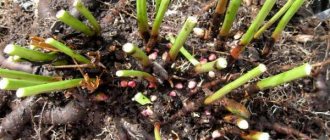Author: Elena N. https://floristics.info/ru/index.php?option=com_contact&view=contact&id=19 Category: Garden plants Published: January 19, 2019Last edits: April 23, 2021
- How to care for autumn
- When to replant
- Growing from seeds
- Preparing for winter
- Non-double
What is the favorite flower of Hollywood stars Gwyneth Paltrow and Drew Barrymore? That's right: peony. This flower has been admired for thousands of years, but its popularity does not fade. When Marco Polo first saw the peony, he described it as a flower “the size of a cabbage”: flowers of some varieties can reach 25 cm in diameter. Peonies grow in almost every garden, and we eagerly await the beginning of their flowering, when the air is filled with a magical aroma , and bright caps of flowers will appear on the bushes...
- What varieties of peonies are there?
- When and how to plant a peony in the garden?
- How to care for a peony during the season?
- How to prepare a bush for wintering?
You will get answers to these and other questions in our article.
Planting and caring for peonies
- Planting: late August or early September.
- Flowering: May.
- Lighting: bright sunlight in the first half of the day, then bright diffused light or light partial shade.
- Soil: slightly acidic loam.
- Watering: infrequent, but plentiful: 2-3 buckets of water for each adult bush.
- Feeding: the first feeding is carried out in early spring, and from the second week of May, peonies are treated with a solution of mineral or organic fertilizer every month, leaves at a time.
- Reproduction: root cuttings and seeds (rarely).
- Pests: bronze beetles, turf ants, root-knot nematodes.
- Diseases: gray rot, rust, brown spot, septoria, root rot, viral mosaic.
Read more about growing peonies below.
flower (lat. Paeonia) is a monotypic genus of herbaceous perennials, the only one in the Peony family. There are herbaceous types of peonies, tree peonies, and also types that combine the properties of both tree and herbaceous peonies - about forty species in total. In nature, peony flowers grow in the temperate and subtropical zones of North America and Eurasia. Cultural cultivation of peonies began in China during the Han era, more than two thousand years ago. The peony flower is named after the legendary healer Pean, who saved both gods and people from mortal wounds received in battles. In our gardens, we mainly grow herbaceous peony, highly valued by gardeners for the beautiful fragrant buds that decorate the flowerbed from May for a month and a half. Our story will be about these peonies.
Botanical description
Peonies are herbaceous, semi-shrub (tree peonies) or shrubby plants, reaching a height of 1 m. The rhizome is large, the roots are cone-shaped, powerful. There are several stems, trifoliate or unpaired pinnate leaves of all shades of green, glaucous or dark purple are arranged alternately along the stems. Peony flowers are single, fragrant, reaching 15-20 cm in diameter; they are good both on the bush and as a cut flower. Peony is unpretentious, its agricultural technology is not difficult, so it has always been valued by flower growers: even when the flowers fade, peony bushes with openwork lush foliage remain attractive until autumn.
- Planting marigolds for seedlings
Peonies are long-lived; they can grow in one place for decades.
Breeders also showed interest in this garden plant, and to date, over five thousand varieties of peonies have been registered, bred mainly with the participation of species such as peony lactiflora and peony officinalis. Varieties of peonies differ in the color of the flowers, their size, flowering time, outline and height of the bush.
Site selection and soil kitchen
The decorativeness of peonies, their viability and longevity depend on how correctly we choose the place for planting peonies. After all, peonies do not particularly like transplanting, and can “live” in the same flowerbed for decades.
Therefore, the place for it must be chosen especially carefully so as not to disturb the plant again.
The peony is very capricious regarding its planting location, and if it doesn’t like it, then it may not bloom. And no matter how diligently you care for it (feeding, watering, loosening), the peony will not bloom. So we quickly dig up our capricious beauty and transplant it to another place.
It is best for this to be an open, sunny place, but at the same time protected from strong and cold winds.
Peonies do not like damp wetlands, so if in the place where you plan to plant them the groundwater comes close to the surface of the soil, then you should plant the plants on raised earthen beds.
It is not recommended to plant peonies closer than 2 m from buildings, because this creates very unfavorable conditions for their growth: in spring and autumn, increased soil moisture due to drops from the roof; and in summer, plants can overheat due to the fact that the walls emit heat.
It is also undesirable to plant peonies close to trees and shrubs, since shade and a constant lack of water and nutrients will prevent them from blooming luxuriantly.
I told you, dear readers, about general recommendations for where to plant peonies, but what specific wishes your plant will have will need to be checked in practice.
For example, at my neighbor’s dacha, peonies grow beautifully and bloom magnificently right next to the wall of the house.
Although peonies can grow on all types of garden soil, they will develop differently.
So, for example, on sandy soil they have more stems, leaves and renewal buds on the rhizomes, while the stems grow thin, the leaves and flowers are small.
If your soil is clayey, then the plants develop slowly: the number of stems does not increase so quickly and, accordingly, peonies reproduce more slowly, but the stems grow thick, the flowers are very large and the leaves are powerful.
It is believed that loamy soils rich in nutrients, well-drained, but quite moisture-intensive soils are best suited for peonies, since such powerful plants with large leaves simply need water throughout the growing season.
Peony does not like to grow on peat soils, due to the fact that the plant sometimes lacks moisture, sometimes has too much moisture, sometimes gets overheated, sometimes gets too cold - no consistency.
In addition, the increased acidity of this soil can cause such a dangerous disease as gray rot.
Therefore, if you have such soil, then before planting you simply need to add ash, sand, bone meal, as well as organic fertilizers to it, thereby reducing its acidity.
Sandy loam soil can also be improved by adding some clay and peat and, of course, organic fertilizers.
Planting peonies
How to plant
Growing peonies will not require a lot of time or excessive effort from you. The most important thing is to choose the right area for peonies, because they will grow there for many years. The root system of adult plants reaches a depth of 70-90 cm, so replanting a bush that has reached 4-5 years of age is not an easy task. Peonies prefer to grow in well-lit areas; sunlight for 5-6 hours in the morning is highly desirable. But peonies are afraid of drafts, so it would be nice if they were protected by tall bushes or trees.
Do not plant peonies in low areas: the rhizomes can rot from stagnant water.
In the photo: Growing peonies in a flower bed
As for the choice of soil, loam with an acidity of 6-6.6 pH is best suited for peonies. If the soil is too clayey, you will need to add humus, sand and peat. In sandy - peat, clay and humus. Sand, wood ash and organic matter are added to peat soils.
Autumn planting
Peonies are planted and replanted in late August - early September. A week before planting peonies, they dig holes measuring 60x60x60 cm at a distance of 70-100 m from each other; a drainage layer of 20-25 cm of coarse sand, broken brick or crushed stone must be laid at the bottom of the holes. Then a layer of top dressing consisting of compost, humus, 100 g of lime, 200 g of superphosphate, 100 g of potassium sulfate, 300 g of wood ash is poured in a layer of 20-30 cm. Then the holes are filled to the top with earth mixed with compost. In a week, by the time the peonies are planted, the soil in the hole will have subsided, which will make it possible to place the peony rhizome in the hole, sprinkle it with garden soil and lightly compact the soil.
Keep in mind that peonies do not tolerate deep planting: the result will be a dense green bush without flowers.
If you want to wait for lush flowering from peonies, deepen the rhizome so that the upper bud is no deeper underground than 3-4 cm. In addition, in the first year after planting or transplanting, peonies do not bloom and look lethargic. It happens that peonies will not bloom the next year, but this is not a problem if the bush looks healthy - it’s just that the peony bush has not yet reached maturity.
In the photo: Peony bud
Planting in spring
Actually, peonies are not planted in the spring. But it happens that in the spring you received the planting material you dreamed of... and what to do? In this case, experts suggest planting peonies in a 2-3-liter pot and keeping them in a cool, dark room - a basement or cellar - until planting them in the ground, keeping the soil moist. To do this, you need to place snow or pieces of ice on top of the soil, which, when melted, will moisten the soil in the pot. At the end of April or May, the peony is taken out into the garden and buried in the ground directly with the pot, where it will remain until the autumn transplant into a prepared hole, carried out by transshipment, that is, together with the earthen lump in which the rhizome was located.
When to plant peonies in spring
Spring peony planting should be carried out as early as possible, in the middle zone - best in April. This is due to the fact that in cool weather the peony begins to develop slowly and gradually; the above-ground part does not outstrip the root system in development.
When to plant peonies in spring according to the lunar calendar 2022
Many gardeners are guided when working with plants by favorable days of the Lunar calendar.
| Month | Better days | Month | Better days |
| January | 25-27, 29-31 | July | 6-8, 23-27, 30, 31 |
| February | 3-14, 17-23 | August | 2-6, 8-10, 12, 14, 22-24, 29-31 |
| March | 3-8 | September | 5-8, 13-15 |
| April | 3-7, 12-15, 25-30 | October | 2-4, 8-15, 20-22 |
| May | 2-5, 7-12, 18-25, 27-29 | november | 3, 4, 9-12, 19-23 |
| June | 1-3, 6-8, 23-26 | December | 1, 2, 4-6 |
In 2022, unfavorable days fall on the following dates:
- January – 2, 3, 17, 18
- February – 1, 2, 16, 28
- March – 1, 2, 18, 27, 28
- April – 1, 2, 16, 23
- May – 1, 16, 30
- June -14, 18, 29
- July – 13, 14, 28, 29
- August – 11, 12, 27-28
- September: 9-10, 26, 27
- October: 9, 10, 25, 26
- November: 1, 2, 7-9, 24, 25, 28, 29
- December: 7-9, 23-25
Caring for peonies
How to care for autumn
In autumn, as already mentioned, it is time to plant and replant peonies. Peonies are not planted every year, and if you have no plans to propagate them this year, caring for peonies in the autumn comes down to trimming withered stems and leaves, which then need to be burned to destroy viruses, bacteria and pests that may , they settled in them. The remaining stems on the bushes should be sprinkled with ash at the rate of 2-3 handfuls per bush. That's all there is to do in the fall. Now we’ll tell you how to care for peonies in the spring.
In the photo: Blooming pink and white peonies
Spring care
Peonies require infrequent but plentiful watering - 2-3 buckets for each adult bush, so that the soil is wet to the depth of the roots. Plants especially need moisture in early spring, during the growth period, as well as during budding and flowering, and in August-September, when new buds are formed in peonies. After watering, it is imperative to loosen the soil around the bushes and remove weeds, if any. Make sure that when watering the water gets under the bush and not on the leaves.
Top dressing
As soon as the snow melts, the ground around the bushes is watered with a solution of potassium permanganate at the rate of 2-3 g per 10 liters of water for two peony bushes. When the shoots begin to grow, you need to fertilize the plants with ammonium nitrate at the rate of 15 g of nitrate per 10 liters of water. Starting from the second week of May, young plants are watered once a month over the leaves from a watering can with a sieve with a solution of complete mineral fertilizer in the recommended concentration. Add washing powder to the solution at the rate of 1 tablespoon per 10 liters of water - this will prevent the solution from simply flowing down the leaves into the ground. Feeding is done in the evening or on a cloudy day.
How to grow hydrangea from cuttings - instructions
- Zamanikha: cultivation, properties and contraindications
During the period of budding and flowering, it is necessary to mineralize the soil with the following solution: 10 g of superphosphate, 7.5 g of ammonium nitrate, 5 g of potassium salt per 10 liters of water. Two weeks after the end of flowering, you need to feed the peonies with a solution of 10 g of superphosphate and 5 g of potassium salt per 10 liters of water. You can alternate mineral fertilizers with organic ones, and instead of a solution, scatter dry fertilizers in the furrow around the bush, followed by moistening and embedding into the soil.
In the photo: Opening peony bud
Caring for peonies in the summer , after the peonies have bloomed, consists of timely watering, fertilizing after flowering, weeding and loosening the area.
Trimming
When to prune peonies? Complete pruning of peony stems is done in late autumn, when frost sets in. But if there is a need to do this earlier, then try to cut the stems not too low, leaving shoots with three to four leaves above the surface of the ground. The fact is that at the end of summer, peonies lay replacement buds, and the success of this process directly depends on the presence of leaves on the bush. Therefore, by the way, when cutting flowers you need to follow this rule: cut the peduncle not very close to the root, leave a part of the stem with several leaves on the bush.
Basic questions when growing
Why don't peonies bloom?
Most of the reasons are associated with errors in agricultural technology, starting from the moment of planting.
- For cultivation, low-lying areas with damp and marshy soil are chosen. This leads to disruption of air exchange and rotting of the rhizome.
- The growth and flowering of the bush is affected by the acidity of the soil. It is important to determine this level before planting and, if necessary, deoxidize the soil with fluff lime or dolomite flour.
- planting in shady places, for example, next to a large tree, will result in the peony constantly having little light.
- An important point is the planting depth. Deepening the root collar promotes the development of renewal buds and new roots on the shoots. But at the same time, this inhibits the warming up of the plant and the formation of flower buds. It is necessary to determine the optimal planting depth so that the root collar is protected in winter and warmed up as much as possible in summer.
The flowering of peonies is affected by the age of the bush. Old, overgrown peonies bloom worse; they need to be divided and replanted after 5–7 years. But frequent transplants also weaken the plant after 1–2 years and prevent the formation of full-fledged buds.
Lack of moisture also affects the condition of the bush and the budding process. On dry and hot spring days, peonies are watered abundantly.
You should not expect abundant flowering if peonies are overfed with nitrogen, the excess of which is difficult to wash out of the soil. Such plants will only actively grow lush green foliage, but not flowers.
Bushes that are heavily damaged by diseases or pests bloom poorly or do not bloom at all.
Why did dark spots appear on peony leaves after flowering?
After flowering - in June-July, brown spots on the leaves appear due to the development of rust and various spots. Darkening of the leaves can occur due to an excess of nitrogen.
Why does the peony dry out?
The main causes of wilting and drying of peony leaves and stems are viral and fungal diseases, root rot, and lack of watering during drought.
Why do you need to pinch the buds?
The buds are often pinched from young 1-2 year old bushes. During this period, intensive development of the bush and root system takes place, and the removal of buds prevents peonies from expending energy on early flowering.
In most varieties of peonies, the flowering shoot has a central and lateral buds. When the side buds reach the size of a large pea, they are plucked out, which allows you to have larger flowers. Usually, a third of the central buds of weaker shoots are plucked out on a peony bush. This technique allows the plants to bloom profusely every year. If the size of the flowers does not matter, then pinching the buds on an adult plant is not necessary.
If you still don't have a peony in your garden, you need to plant one. This luxurious long-lived flower will become a symbol of the garden, bringing a lot of joy not only to the current generation, but also to the future, and will preserve the memory of the past.
You will learn more about how to care for peonies in the video.
Transplanting peonies
When to replant
Wild peonies grow in one place for up to fifty years or even more. Hybrid varieties that originate from the officinalis peony can grow without replanting in the same area for no more than ten years; after this period, the bush must be divided and transplanted to another place. In addition, dividing and planting the bush is the easiest and most reliable way to propagate peonies. But for this purpose, 4-5 year old bushes are used, which have already fully bloomed once or twice. The fact is that the root system of peonies grows greatly over the years, so it is easier to cope with a younger rhizome than with an old one, so in order to ensure that the quality of flowering of your peonies does not decrease, it would be better to divide and plant the bushes every three to four years . Peonies are replanted in September.
In the photo: White peony flower
Autumn transplant
How to replant peonies? In autumn, the bush is dug at a distance of 25 cm from the rhizome, then carefully loosened with a pitchfork and removed from the ground. The rhizome is cleared of soil with a peg, then washed with a not very strong stream of water so as not to damage the fragile buds and eyes of the peonies. The above-ground part is cut off almost to the root. The washed rhizome is left in the fresh air so that the water drains and the roots slightly wither and become more elastic. Then the old thick roots are trimmed to a length of 10-15 cm at an angle of 45º.
Carefully examine the root and only then proceed with division.
If the bush is old, then it is most convenient to drive a wedge into its middle with a hammer, which will split the rhizome into several parts. Often in the middle of old rhizomes there are voids and rotten areas that need to be cleaned, disinfected with a strong solution of potassium permanganate, and then the sections are powdered with fungicide. The divisions should consist of part of the root collar with well-developed 3-4 eyes and several roots. You need to try to divide the rhizome into approximately equal parts, so that there are no too large sections that will hurt for a long time after transplantation, or too small ones that may die.
In the photo: Growing peonies in the garden
How to replant
You need to plant the cuttings in the ground using the method that has already been described. The area with transplanted plants must be mulched with a seven-centimeter layer of peat for the winter; the mulch can be removed when reddish peony sprouts break through it in the spring. During the first two years after transplanting, peonies must develop a root system, so be patient and do not let young plants bloom. In the first year, pinch off all the buds that appear, the next year, leave just one bud on the bush and, when it bursts, cut it as short as possible and consider how well the flower matches its variety. If the match is incomplete, then you will have to pinch off the buds for another year, leaving only one, until the flower fully matches its variety. This may happen in the third year, or maybe in the fifth.
Preparing for winter and sheltering for the winter
Most herbaceous species do not require special shelter. But tree peonies , despite the fact that they are considered frost-resistant in the conditions of the Middle Zone, need to be covered for the winter. Under dry and warm shelter, the bush will successfully overwinter and delight you with flowering next year.
In October, the stems of the tree peony are carefully tied, trying not to damage them. A layer of peat, straw, dry leaves or pine litter is scattered on the ground around the trunk. A hut is built around the bush from wooden blocks or metal rods, which is covered with spunbond, burlap and secured with ropes for reliability when frost arrives.
Peony propagation
Growing from seeds
You are already familiar with the vegetative propagation of peonies by dividing the bush. Peonies also reproduce in other ways, for example, by seed. But it should be remembered that peony seeds do not always retain varietal qualities, therefore, as a rule, only breeders use them. And plants grown from seeds bloom only in the fourth or fifth year. But if you want to try to develop a new variety, then sow freshly collected seeds in August directly into loose soil, and next spring they will germinate.
Rare ways to propagate roses
Propagation by root cuttings
This is the most reliable way to propagate peonies. A small piece of rhizome with a dormant bud is separated from the bush in July, planted, and by September it has already taken root. True, this method is not suitable for those who are in a hurry: such shoots develop slowly and will be able to bloom for the first time in five years.
How to choose planting material?
When planning a flower garden, many inexperienced gardeners think only about how and where to plant peony and ava, but often do not think about what planting material to use. Many even strive to get a large mature plant so that it begins to bloom in the first summer after planting.
In fact, this approach is fundamentally wrong, since a good peony can only come from a young plant. But the big old bushes, although they look impressive, hardly deserve attention. If you buy an old bush, it may flower in its first year, but it is very likely that this will be its last year of life. Since peonies do not take root very well in a new place, it is possible that after such stress the plant will quickly wither.
When it comes to peonies, the best planting material that can take root and will delight you for many years are one- or two-year-old plants grown in a nursery. As a last resort, you can use seedlings obtained by dividing large bushes. The main thing is that such a “division” has at least 2-3 buds and a viable piece of rhizome.
Peonies after flowering
Peonies have faded - what to do? Peonies bloom in late May or early June. Remove all faded flowers, after two weeks, apply a third fertilizing with phosphorus and potassium fertilizers and continue to water the plants regularly. In August, watering should become more abundant, since the period of formation of replacement buds begins, and the plant will need moisture.
How and when to plant lilies - proven tips
Preparing for winter
When the leaves and stems of peonies begin to turn yellow, watering should be gradually reduced, and when frost sets in, the above-ground part of the bush should be cut back almost to soil level. If you replanted old peonies or planted new ones in the fall, you will have to cover this area with a layer of peat mulch of 5-7 cm so that the weak peonies after transplantation feel comfortable in winter. In the spring, when peonies sprout, the mulch layer can be removed.
- How and when to plant helenium (video)
In the photo: Peony seeds
Peonies in winter
Peonies spend the winter in the garden. Old bushes are not afraid of frost, and if you have covered young peonies for the winter, you can rest assured that your flowers will not die.
How to care after planting
After you have planted your peonies in open ground, a period of intensive plant care begins. You should start by loosening the soil, followed by watering as needed and, of course, fertilizer.
You need to water the bushes abundantly, but not often. They do not like constant moisture .
Mixtures with a large amount of minerals and nitrogen are suitable as fertilizers. It is recommended to fertilize only when the soil is moist, so all substances will penetrate into the roots much faster. It is better to pour the fertilizer into a special hole at a distance of about ten centimeters around the bush.
Interesting fact! Young peony bushes love feeding even in the summer. Special foliar feeding will be useful for them. This solution must be applied at intervals of up to 20 days from the moment the first shoots appear.
In dry times, one bush will need from 10 to 15 liters of water, depending on its size. The main thing is to maintain soil moisture for at least the first month after spring planting.
Particular attention should be paid to blooming and young peonies. They should be regularly removed with faded flowers. In summer, the plants are weeded. In autumn, shoots are cut off before the onset of frost.
Proper planting and care of the plant will allow your flowers to bloom in the first 2 years. And then they will only grow more and more, delighting you and your guests.
Diseases and pests
Of all the existing diseases, peonies most often suffer from gray rot - botrytis. This disease manifests itself in mid-May with rotting of the stems, although botrytis can affect both buds and leaves - parts of the plant become covered with gray mold. Excess nitrogen, crowded flowerbeds and rainy weather contribute to the appearance of gray rot. Diseased areas should be cut off and burned away from all plants. As a preventive measure, spray with a solution of copper sulfate (50 g per 10 liters of water) or garlic water (10 g crushed garlic per 1 liter of water). You need to spray both the plant and the soil around the bush.
In the photo: Yellow milky peony
Sometimes peonies become infected with powdery mildew, a fungal disease that affects the leaves of peonies and covers them with a white coating. Powdery mildew should be combated by spraying the bush with a soap solution (200 g of laundry soap, 20 g of copper sulfate per 10 liters of water).
Let's help you bloom
In the first year after planting (and better yet in the second), you should not allow the peony to bloom, as it will weaken the plant and prevent the root system from fully developing.
Therefore, the buds that form at this time should be removed so that all nutrients are directed to the general development of the plant, and not to flowering.
So prepare yourself mentally for the fact that you will see the first flowers on a newly planted peony only in the third year, and real full flowering with the size and color of flowers characteristic of the variety will only appear in the fifth year.
If you want to get large upper flowers, then the side buds must be removed when they reach the size of a pea.
If you prefer the abundance of flowers on the bush and its long flowering, then you should not remove the side buds.
Faded peonies should be immediately removed from the stem, cutting them down to the first well-developed leaf and leaving a very small stump.
Otherwise, falling petals falling on the leaves can provoke gray mold disease, especially in rainy weather.
During the flowering period, peony bushes with large, heavy flowers need support, since, even with powerful stems, they inevitably begin to lean towards the ground.
And with strong winds and precipitation, the flowers, bending almost to the ground, become dirty and lose their decorative effect.
It is best to install supports before flowering.
Types and varieties of peonies
According to the structure of the flower, peonies are divided into 7 groups:
Non-double
They have one or two rows of petals. The flowers are large, there are numerous stamens in the center of the flower, the leaves are sometimes corrugated (for example, varieties Golden Glow, Nadya);
Semi-double
Very large, light flowers; the stamens are located either in the center of the flower or between the petals. The flower usually has seven rows of petals. Varieties:
- Miss America is a mid-early variety, a pink flower 25 cm in diameter turns white after opening, the stamens are bright yellow;
- Ann Berry Cousins - an early variety of coral-pink color, cup-shaped flower 17 cm in diameter, bush up to 65 cm tall;
In the photo: Non-double peonies
Japanese
The modified stamens in the center of the flower form a pompom; the petals in the flowers can be in one or several rows. Varieties:
- Carrara is a medium-flowering white variety, 16 cm in diameter, bush height – 80 cm;
- Hot Chocolet is a mid-early peony of dark burgundy color, 16 cm in diameter, height up to 80 cm;
Anemoneaceae
A transitional form from Japanese peonies to the group of double peonies. The lower petals are wide, rounded, arranged in two rows, the central petals, shorter, form a ball. Varieties:
- Rhapsody is a mid-early variety, the marginal petals are pink, the central petals forming a ball are yellow-cream, flower diameter is 16 cm, bush height is 70 cm;
- Snow Mountain – early cream-colored peony, 17 cm in diameter, height – 75 cm;
Terry hemispherical, bomb-shaped, spherical
The petals of the flower are collected in a hemisphere and, when fully opened, form a ball. Varieties:
- Pink Cameo - a medium-late variety of creamy pink color, 16 cm in diameter, bush 80 cm in height;
- Monsieur Jules Ely - an early fragrant variety of lilac-pink color, diameter - 20 cm, height - 90 cm;
In the photo: Semi-double peonies
Rosaceae
The petals of a flower, very similar in structure to a rose, are the same in size, round, wide, large. Varieties:
- Solange is a late creamy-white peony 17 cm in diameter, the height of heavy stems that need support reaches 70 cm;
- Henry Boxtox is an early variety of bright red color, 16 cm in diameter, bush 90 cm tall.
In the group of pink peonies there is a subgroup of semi-rose peonies, which are distinguished by the presence of an island of stamens in the middle of the flower. Varieties:
- Gudi – mid-early, bright crimson, 16 cm in diameter, height – 70 cm;
- Ballerina is an early variety of white-cream-green color, a powerful bush, flower diameter is 18 cm.
Crown hemispherical and spherical
Flower petals are arranged in three tiers: the upper tier is a ring of petals, the middle one consists of petals that are narrower than those on the upper and lower tier. As a rule, the top and bottom rows are the same color, the middle row may differ in color. Varieties:
- Nancy is an early variety of pink-peach color, 17 cm in diameter, bush up to 80 cm tall;
- Aritina Nozen Gloria is a very early variety of pink-lilac hue, bush height - 70 cm, flower diameter - 20 cm.
Preparation of planting holes
Peonies have a fairly powerful root system that grows in depth and breadth, so it is necessary to prepare a planting hole measuring at least 60-70 cm in diameter and 70 cm in depth.
If we dig a hole that is not deep enough, the peony roots will stop growing when they reach solid ground.
Don't forget to put drainage at the bottom of the planting hole. It can be gravel, coarse sand or broken brick.
Then we fill the lower part of the hole with an earthen mixture, which consists of the top layer of soil, rotted manure, compost and peat, it is also good to add 150-200 g of superphosphate or 300-400 g of bone meal or ash, and if your soil is acidic, then It’s a good idea to also add 200-400 g of crushed slaked lime.
Mix the mixture thoroughly and add water. We fill the upper part of the hole with good garden soil without adding any fertilizers, and we will plant the plant in it.
I recommend preparing the planting hole in advance, about a month before planting, so that the soil has time to settle.
If you were unable to do this and prepare the hole right before planting the peonies, then the soil must be lightly compacted so that after planting it does not settle and then the planted plant may end up not being at the depth required, which will negatively affect the growth of the plant .











